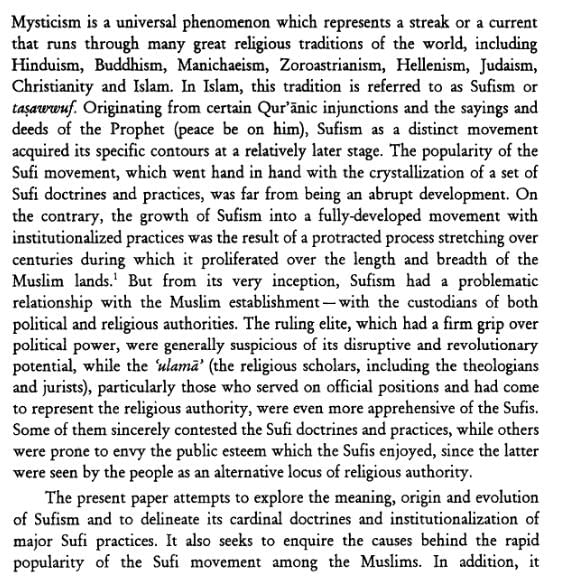Humanities/Arts Exam > Humanities/Arts Questions > What aspects of relationship between the Sufi...
Start Learning for Free
What aspects of relationship between the Sufis and the State ? What does the account tell us about the modes of communication between The Shaikh and his Disciples?
Verified Answer
What aspects of relationship between the Sufis and the State ? What do...
Relationship between the Sufism and the State :

 This question is part of UPSC exam. View all Humanities/Arts courses
This question is part of UPSC exam. View all Humanities/Arts courses
Most Upvoted Answer
What aspects of relationship between the Sufis and the State ? What do...
The Relationship between the Sufis and the State
In the account, the relationship between the Sufis and the State is depicted as complex and multifaceted. The State, represented by the political and religious authorities, often viewed the Sufis with suspicion due to their non-conformist practices and spiritual teachings. However, the Sufis also had a significant influence on the State and its policies.
Resistance and Opposition
- The Sufis often resisted the authority of the State, particularly when it contradicted their spiritual beliefs and practices. They emphasized the importance of inner spiritual experiences over outward rituals and formalities prescribed by the State.
- The Sufis also opposed the State's attempts to control and regulate religious practices, advocating for individual freedom in matters of faith.
State Suppression and Persecution
- The State, feeling threatened by the growing popularity and influence of the Sufis, often resorted to suppression and persecution. Sufi practices and gatherings were banned, and Sufi leaders were subjected to imprisonment and torture.
- Despite the State's efforts, the Sufis continued to thrive and gain followers, demonstrating their resilience and the appeal of their teachings.
Influence on the State
- While the State saw the Sufis as a potential threat, it also recognized their influence and sought to co-opt them for political purposes. The State often used the Sufis' popularity and spiritual authority to legitimize its rule.
- Sufi leaders were sometimes invited to the court, where they would offer guidance and advice to the rulers. This interaction between the Sufis and the State allowed for a delicate balance of power, with the Sufis exerting their influence while remaining independent.
The Modes of Communication between the Shaikh and his Disciples
The account provides insights into the modes of communication between the Shaikh (Sufi master) and his disciples, highlighting the unique and intimate nature of their relationship.
Oral Transmission
- The primary mode of communication was oral transmission, with the Shaikh imparting his spiritual teachings and guidance through direct conversations and personal interactions with his disciples.
- The disciples would gather around the Shaikh, listening attentively to his words and seeking his advice on matters of spirituality and daily life.
Symbolism and Metaphors
- The Shaikh often employed symbolism and metaphors to convey deeper spiritual meanings to his disciples. These symbolic teachings helped the disciples grasp abstract concepts and gain a deeper understanding of the spiritual path.
- The disciples, in turn, would contemplate and interpret the symbolic teachings, engaging in a dialogue with the Shaikh to clarify their understanding.
Spiritual Practices and Experiences
- The disciples learned from the Shaikh not only through verbal communication but also through shared spiritual practices and experiences. The Shaikh would guide them in meditation, prayer, and other contemplative practices, allowing them to directly experience spiritual insights.
- These shared practices created a sense of unity and intimacy between the Shaikh and his disciples, fostering a deep bond of trust and devotion.
In conclusion, the relationship between the Sufis and the State was marked by resistance, persecution, co-optation, and influence. The modes of communication between the Shaikh and his disciples involved oral transmission, symbolism, metaphors, and shared spiritual practices, creating a unique and profound connection.
In the account, the relationship between the Sufis and the State is depicted as complex and multifaceted. The State, represented by the political and religious authorities, often viewed the Sufis with suspicion due to their non-conformist practices and spiritual teachings. However, the Sufis also had a significant influence on the State and its policies.
Resistance and Opposition
- The Sufis often resisted the authority of the State, particularly when it contradicted their spiritual beliefs and practices. They emphasized the importance of inner spiritual experiences over outward rituals and formalities prescribed by the State.
- The Sufis also opposed the State's attempts to control and regulate religious practices, advocating for individual freedom in matters of faith.
State Suppression and Persecution
- The State, feeling threatened by the growing popularity and influence of the Sufis, often resorted to suppression and persecution. Sufi practices and gatherings were banned, and Sufi leaders were subjected to imprisonment and torture.
- Despite the State's efforts, the Sufis continued to thrive and gain followers, demonstrating their resilience and the appeal of their teachings.
Influence on the State
- While the State saw the Sufis as a potential threat, it also recognized their influence and sought to co-opt them for political purposes. The State often used the Sufis' popularity and spiritual authority to legitimize its rule.
- Sufi leaders were sometimes invited to the court, where they would offer guidance and advice to the rulers. This interaction between the Sufis and the State allowed for a delicate balance of power, with the Sufis exerting their influence while remaining independent.
The Modes of Communication between the Shaikh and his Disciples
The account provides insights into the modes of communication between the Shaikh (Sufi master) and his disciples, highlighting the unique and intimate nature of their relationship.
Oral Transmission
- The primary mode of communication was oral transmission, with the Shaikh imparting his spiritual teachings and guidance through direct conversations and personal interactions with his disciples.
- The disciples would gather around the Shaikh, listening attentively to his words and seeking his advice on matters of spirituality and daily life.
Symbolism and Metaphors
- The Shaikh often employed symbolism and metaphors to convey deeper spiritual meanings to his disciples. These symbolic teachings helped the disciples grasp abstract concepts and gain a deeper understanding of the spiritual path.
- The disciples, in turn, would contemplate and interpret the symbolic teachings, engaging in a dialogue with the Shaikh to clarify their understanding.
Spiritual Practices and Experiences
- The disciples learned from the Shaikh not only through verbal communication but also through shared spiritual practices and experiences. The Shaikh would guide them in meditation, prayer, and other contemplative practices, allowing them to directly experience spiritual insights.
- These shared practices created a sense of unity and intimacy between the Shaikh and his disciples, fostering a deep bond of trust and devotion.
In conclusion, the relationship between the Sufis and the State was marked by resistance, persecution, co-optation, and influence. The modes of communication between the Shaikh and his disciples involved oral transmission, symbolism, metaphors, and shared spiritual practices, creating a unique and profound connection.

|
Explore Courses for Humanities/Arts exam
|

|
Question Description
What aspects of relationship between the Sufis and the State ? What does the account tell us about the modes of communication between The Shaikh and his Disciples? for Humanities/Arts 2025 is part of Humanities/Arts preparation. The Question and answers have been prepared according to the Humanities/Arts exam syllabus. Information about What aspects of relationship between the Sufis and the State ? What does the account tell us about the modes of communication between The Shaikh and his Disciples? covers all topics & solutions for Humanities/Arts 2025 Exam. Find important definitions, questions, meanings, examples, exercises and tests below for What aspects of relationship between the Sufis and the State ? What does the account tell us about the modes of communication between The Shaikh and his Disciples?.
What aspects of relationship between the Sufis and the State ? What does the account tell us about the modes of communication between The Shaikh and his Disciples? for Humanities/Arts 2025 is part of Humanities/Arts preparation. The Question and answers have been prepared according to the Humanities/Arts exam syllabus. Information about What aspects of relationship between the Sufis and the State ? What does the account tell us about the modes of communication between The Shaikh and his Disciples? covers all topics & solutions for Humanities/Arts 2025 Exam. Find important definitions, questions, meanings, examples, exercises and tests below for What aspects of relationship between the Sufis and the State ? What does the account tell us about the modes of communication between The Shaikh and his Disciples?.
Solutions for What aspects of relationship between the Sufis and the State ? What does the account tell us about the modes of communication between The Shaikh and his Disciples? in English & in Hindi are available as part of our courses for Humanities/Arts.
Download more important topics, notes, lectures and mock test series for Humanities/Arts Exam by signing up for free.
Here you can find the meaning of What aspects of relationship between the Sufis and the State ? What does the account tell us about the modes of communication between The Shaikh and his Disciples? defined & explained in the simplest way possible. Besides giving the explanation of
What aspects of relationship between the Sufis and the State ? What does the account tell us about the modes of communication between The Shaikh and his Disciples?, a detailed solution for What aspects of relationship between the Sufis and the State ? What does the account tell us about the modes of communication between The Shaikh and his Disciples? has been provided alongside types of What aspects of relationship between the Sufis and the State ? What does the account tell us about the modes of communication between The Shaikh and his Disciples? theory, EduRev gives you an
ample number of questions to practice What aspects of relationship between the Sufis and the State ? What does the account tell us about the modes of communication between The Shaikh and his Disciples? tests, examples and also practice Humanities/Arts tests.

|
Explore Courses for Humanities/Arts exam
|

|
Signup for Free!
Signup to see your scores go up within 7 days! Learn & Practice with 1000+ FREE Notes, Videos & Tests.























